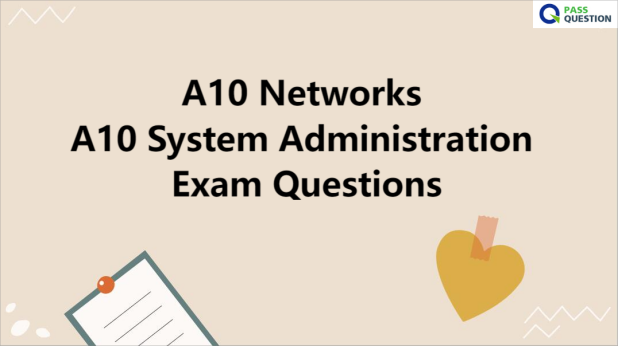A10 Networks A10 System Administration Exam Questions
The A10 Networks Certified Professional A10 System Administration certification exam is a valuable credential and a milestone in your IT career. It opens doors to opportunities and leads to a successful future in the IT industry. To ensure your success in the A10 System Administration Exam, PassQuestion provides an extensive collection of the latest A10 Networks A10 System Administration Exam Questions that are designed to cover all the essential topics and concepts that will be tested in the exam. By studying these A10 Networks A10 System Administration Exam Questions, you will not only enhance your knowledge but also gain the confidence needed to pass the exam with ease.

What is A10 Certified Professional System Administration 4?
A10 Certified Professional System Administration 4 is a certification program offered by A10 Networks. It is designed to validate the knowledge and skills of professionals in the field of system administration related to A10 Networks products. By obtaining this certification, professionals demonstrate their expertise in A10 system administration and enhance their career prospects in the IT industry. The prerequisites for the A10 Networks Certified Professional A10 System Administration certification exam include knowledge of the OSI reference model, network topology and administration, and familiarity with an industry-standard switching and routing CLI. The audience for this exam includes professionals in network operations, development operations, and network security, as well as students preparing for application courses.
Exam Objectives
From a set of three blank ACOS devices, students build a system deployment with these attributes:
- Layer 2 – 3 environment including VLANs, and IP routing
- Device cluster environment with a single management point
- High availability with multiple active devices
- Multi-tenant environment with limited-scope administration
- Remote authentication and authorization
- Students also use device tools that monitor, diagnose, and restore the system configuration.
Exam Outline
Initial ACOS Configuration
- Base system configuration through the CLI and GUI
- Backup and restore
- System upgrade
- Configuration profiles
Centralized Configuration Management: aVCS
- Clustering devices into a centralized chassis
- aVCS topology: vMaster and vBlade devices
- vMaster election and maintenance
High Availability: VRRP-A
- Active-Standby mode and failover
- N+M deployments
- Active device selection
Application Delivery Partitions (ADP)
- Layer 3 Virtualization Partitions (L3V)
- Shared and private partitions
- Public and private objects
Role-based Administration
- Admin account creation through the CLI and GUI
- Assigning privileges, passwords, and access rights
- Roles: predefined and user-defined
- Session management
Authentication, Authorization, and Accounting
- Using AAA servers to manage device and command access
- Account and command tracking
Control Plane Logging
- ACOS logging
- External logging and emailing events
- Events and thresholds
SNMP
- Monitoring ACOS devices remotely
- A10 MIBs
- Configuring Traps
- OID discovery
aXAPI Overview
- aXAPI architecture and session flow
- API methods
View Online A10 Networks A10 System Administration Free Questions
1.Select the statement that describes aXAPI authentication and authorization requirements:
A. aXAPI requires that users are assigned to the “aXAPI” role before they can execute a script.
B. aXAPI is subject to the same permissions requirements as the CLI and GUI.
C. aXAPI has special permissions that differ from CLI and GUI permissions.
D. aXAPI is subject to authorization but not authentication requirements.
Answer: C
2.What do we know about the state of the system from the CLI prompt? (Choose two.)
A1-vMaster[1/1][Helium2]#
A. There is only 1 member in this A10 Virtual Chassis.
B. There are at least 2 private partitions configured.
C. aVCS has been configured, and this host is part of aVCS set 1.
D. aVCS has been configured, and this host is part of aVCS set 1/1.
E. Application Delivery Partitions have been configured.
Answer: D,E
3.In a VRRP-A topology that contains four devices, select the number of devices on which a single VRID can be simultaneously active?
A. 1
B. 2
C. 3
D. 4
Answer: A
4.When vBlade A issues a “vcs vmaster-take-over 200” command, which statement is true?
A. The command is ignored when the current vMaster is in vMaster maintenance mode.
B. Any subsequent vmaster-take-over command within the chassis with a parameter smaller than 201 is ignored.
C. The 200 priority is compared to the current vmaster’s default vrid priority to determine which device controls the chassis.
D. If an administrator on vBlade B were to simultaneously issue command vcs vmaster-take-over 210, vBlade B would become the vMaster.
Answer: C
5.ACOS can log the following accounting records for administrative sessions:
A. device access attempts only
B. syslog errors of a specified severity level
C. device access and command entry attempts
D. command entry attempts only
E. syslog errors of severity greater than a specified level
Answer: C
6.Which statement describes the effect this command:
erase preserve-management
A. The startup-config file is erased and the ACOS is immediately rebooted
B. All configuration profiles, SSL certificates, aFlex polices, black/white lists, and system logs are erased the next time the system reboots
C. The startup-config file is erased but the management interface ip configuration is kept
D. The start-up config file is erased but the all of the admin accounts are preserved
Answer: C
7.Which commands display the ACOS device serial number? (Choose two.)
A. show system
B. show hardware
C. show environment
D. show serial
E. show version
Answer: B,E
8.Select two aXAPI implementation use cases. (Choose two.)
A. Auto-syncing the configurations via virtual chassis.
B. Extract ACOS configurations or statistics from ACOS.
C. Perform deep packet inspection on traffic and redirect and modify content.
D. Writing scripts to automate configuration changes.
Answer: B,D
- TOP 50 Exam Questions
-
Exam
All copyrights reserved 2026 PassQuestion NETWORK CO.,LIMITED. All Rights Reserved.

